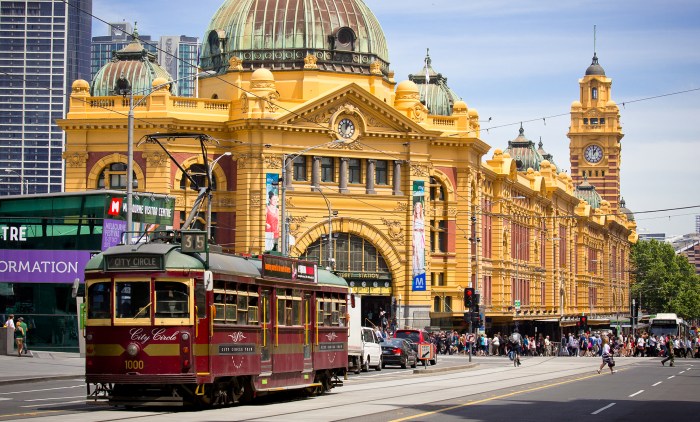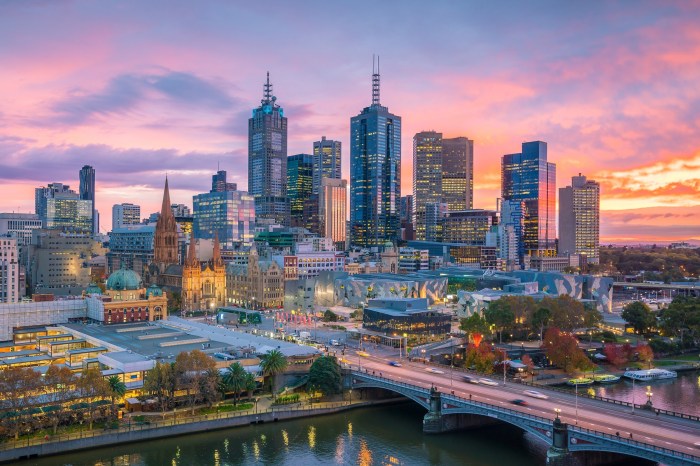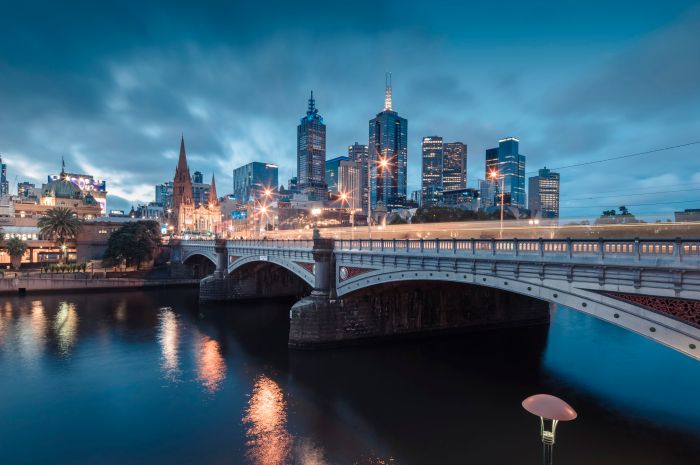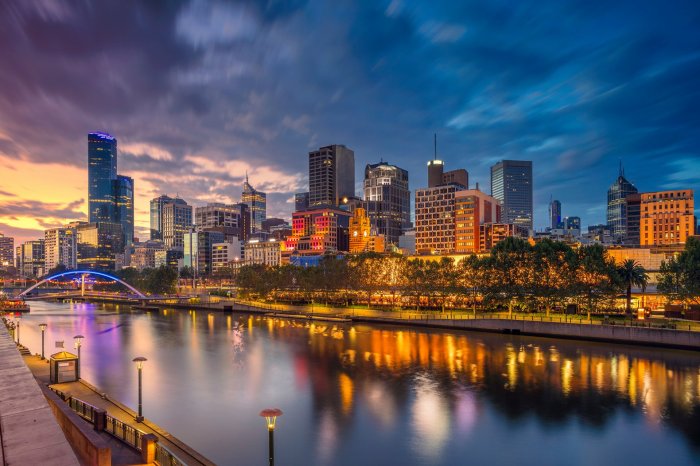Melbourne, the captivating capital of Victoria, Australia, stands as a beacon of culture, culinary delights, and sporting prowess. This dynamic city has earned its reputation as one of the world’s most livable, offering an unparalleled blend of urban sophistication and natural beauty.
From its vibrant arts scene to its iconic landmarks, from its diverse culinary offerings to its passion for sports, Melbourne embodies the essence of a modern metropolis. Immerse yourself in this captivating city and discover its many charms.
Melbourne City Overview
Melbourne, the vibrant capital of Victoria, Australia, is renowned for its cultural richness, sporting prowess, and economic significance. Located on the southeastern coast of Australia, at the northern end of Port Phillip Bay, Melbourne’s geographic position has played a pivotal role in its growth and development.
Established in 1835 as a pastoral settlement, Melbourne rapidly transformed into a thriving metropolis during the Victorian gold rush era of the mid-19th century. Today, it is Australia’s second-largest city, home to a diverse population of over 5 million people.
Demographic Profile
Melbourne is a multicultural city, with a significant proportion of its population born overseas. The city boasts a high standard of living, ranking among the world’s most livable cities. Melbourne’s population is characterized by its youthful demographics, with a median age of 37 years.
Economic Indicators
Melbourne is the economic powerhouse of Victoria, contributing significantly to Australia’s overall economy. The city is a hub for finance, manufacturing, tourism, and education. Melbourne’s gross domestic product (GDP) is estimated at over $380 billion, making it one of the wealthiest cities in Australia.
Melbourne Culture and Arts
Melbourne is renowned as a cultural hub in Australia, boasting a vibrant and diverse arts scene that attracts visitors from around the globe.
The city’s music scene is particularly noteworthy, with a plethora of live music venues hosting everything from indie rock to classical performances. Notable venues include the iconic Melbourne Recital Centre and the intimate Corner Hotel.
Theatre
Melbourne’s theater scene is equally vibrant, with a wide range of productions from Broadway musicals to cutting-edge experimental works. The city is home to several prestigious theater companies, including the Melbourne Theatre Company and the Malthouse Theatre.
Art
Melbourne’s art scene is diverse and dynamic, with a thriving community of galleries and museums. The National Gallery of Victoria is one of the most prestigious art institutions in Australia, showcasing an extensive collection of Australian and international art.
The city is also known for its street art, with vibrant murals adorning buildings and laneways throughout the central business district and beyond.
Events
Melbourne hosts a variety of cultural events throughout the year, including the Melbourne International Film Festival, the Melbourne Fringe Festival, and the Melbourne International Comedy Festival. These events attract a diverse audience and contribute to the city’s vibrant cultural atmosphere.
Melbourne Architecture and Landmarks

Melbourne’s architectural landscape is a captivating blend of Victorian grandeur, contemporary skyscrapers, and innovative designs. Its unique architectural style, influenced by European and American influences, has shaped the city’s iconic skyline.
The city’s rich architectural heritage is evident in its numerous historical buildings, such as the ornate Flinders Street Station and the grand Parliament House. These structures showcase the architectural prowess of the Victorian era and serve as a testament to Melbourne’s early prosperity.
Iconic Landmarks and Buildings
Melbourne’s skyline is dotted with iconic landmarks that define its identity. These include:
- Eureka Tower:The tallest building in Melbourne, offering breathtaking panoramic views from its observation deck.
- Federation Square:A vibrant cultural precinct featuring contemporary architecture and public art installations.
- Royal Exhibition Building:A UNESCO World Heritage Site known for its grand Victorian architecture and historic significance.
Architectural Styles and Notable Structures
Melbourne’s architectural diversity is showcased in its wide range of architectural styles, from the ornate Gothic Revival to the sleek modernism of the 21st century. Notable examples include:
| Architectural Style | Notable Structures |
|---|---|
| Victorian Gothic Revival | St. Paul’s Cathedral, Melbourne Town Hall |
| Art Deco | Manchester Unity Building, Capitol Theatre |
| Modernism | National Gallery of Victoria, Melbourne Museum |
| Postmodernism | Federation Square, Eureka Tower |
Melbourne Food and Dining

Melbourne’s culinary scene is a melting pot of global flavors, reflecting the city’s diverse population and vibrant immigrant communities. From traditional Australian fare to innovative fusion cuisine, there’s something to satisfy every palate.
Coffee culture is deeply ingrained in Melbourne’s identity. The city boasts a vast array of specialty cafes, each with its unique atmosphere and expertly crafted brews. From artisanal roasters to cozy neighborhood hangouts, coffee lovers are spoiled for choice.
Popular Dining Precincts
Melbourne’s dining scene is spread across several vibrant precincts, each offering a distinct culinary experience.
- Lygon Street, Carlton:Known for its authentic Italian restaurants and lively atmosphere.
- Degraves Street, Melbourne CBD:A charming laneway lined with hidden cafes, bars, and eateries.
- Victoria Street, Richmond:A multicultural hub with a wide range of Asian cuisines.
- Southgate, Southbank:A waterfront precinct with upscale restaurants and stunning river views.
Must-Try Dishes
Melbourne’s culinary offerings extend beyond its renowned coffee. Here are a few must-try dishes that showcase the city’s culinary diversity:
- Meat Pie:A savory pastry filled with minced meat and gravy, a classic Australian snack.
- Dim Sum:Steamed or fried dumplings with various fillings, a staple of Cantonese cuisine.
- Laksa:A spicy noodle soup with a coconut-based broth, popular in Southeast Asian cuisine.
- Pavlova:A meringue-based dessert topped with fruit and whipped cream, a traditional Australian treat.
Melbourne Sports and Recreation
Melbourne is renowned as Australia’s sporting capital, boasting a rich sporting legacy and hosting numerous major sporting events. The city is particularly passionate about Australian rules football and cricket, and offers a wide range of parks, gardens, and outdoor recreation opportunities.
Major Sporting Events
- Australian Open Tennis Tournament:Held annually in January, it is one of the four Grand Slam tennis tournaments.
- Melbourne Cup:The “race that stops a nation,” this prestigious horse race takes place on the first Tuesday of November.
- Formula 1 Australian Grand Prix:Held at the Albert Park Circuit, this Formula 1 race attracts drivers and fans from around the world.
- Australian Football League (AFL) Grand Final:The pinnacle of the Australian rules football season, held at the Melbourne Cricket Ground (MCG) in September.
Australian Rules Football and Cricket
Melbourne is the heartland of Australian rules football, with the MCG being the largest stadium in the country and hosting the AFL Grand Final. The city is also home to several AFL teams, including the Melbourne Demons, Collingwood Magpies, and Essendon Bombers.
Cricket is another popular sport in Melbourne, with the Melbourne Cricket Ground hosting international matches and the Big Bash League.
Parks, Gardens, and Outdoor Recreation
Melbourne boasts numerous parks and gardens, providing ample opportunities for outdoor recreation. Some notable green spaces include:
- Royal Botanic Gardens:A UNESCO World Heritage site, featuring a diverse collection of plants and a picturesque lake.
- Fitzroy Gardens:Home to Captain Cook’s Cottage and a charming rose garden.
- Carlton Gardens:Located in the heart of the city, these gardens are known for their elm trees and Melbourne Museum.
- Yarra Bend Park:A large park along the Yarra River, offering hiking trails, picnic areas, and a golf course.
Melbourne Education and Research

Melbourne is renowned as a leading education and research hub in Australia, boasting a vibrant academic landscape and a significant role in scientific innovation.
The city is home to several prestigious universities, including the University of Melbourne, Monash University, and RMIT University. These institutions are consistently ranked among the top universities in the world, offering a diverse range of undergraduate and postgraduate programs across various disciplines.
Melbourne is a vibrant city with a thriving arts and culture scene. If you’re looking to explore beyond Australia, consider a trip to Hong Kong Airport , a major international hub that offers convenient connections to destinations around the world.
Upon your return, you’ll appreciate Melbourne’s charm and its many attractions.
Academic Strengths
The University of Melbourne is particularly renowned for its research strengths in medicine, law, and the social sciences. Monash University is known for its excellence in engineering, biomedical sciences, and information technology. RMIT University is highly regarded for its programs in design, architecture, and business.
Scientific Research and Innovation
Melbourne is also a major center for scientific research and innovation. The city is home to the Walter and Eliza Hall Institute of Medical Research, one of the world’s leading biomedical research institutions. The city also hosts numerous research centers and institutes affiliated with its universities, contributing to cutting-edge research in fields such as biotechnology, nanotechnology, and environmental sustainability.
Melbourne, the vibrant and cosmopolitan city, boasts an eclectic nightlife scene that caters to all tastes. For those seeking a unique and unforgettable experience, a visit to one of the city’s renowned rock bars is a must. These establishments offer a heady blend of live music, delectable cocktails, and a vibrant atmosphere that is sure to leave a lasting impression.
After a night of revelry at a rock bar, you’ll find yourself immersed in Melbourne’s vibrant cultural tapestry, ready to explore all that this dynamic city has to offer.
Melbourne Transportation and Infrastructure

Melbourne’s transportation system is highly developed and efficient, providing residents and visitors with a wide range of options for getting around the city. The public transportation network includes trains, trams, and buses, which are all integrated and offer convenient and affordable travel.
Melbourne’s urban planning and infrastructure development have been guided by a commitment to sustainability and liveability. The city has invested heavily in public transportation, cycling infrastructure, and pedestrian-friendly streets, making it easy for people to move around without relying on cars.
Melbourne is an inspiring metropolis renowned for its cultural vibrancy. Its laneways, teeming with street art and independent cafes, evoke a bohemian charm. However, when seeking a contrasting urban experience, consider central Jakarta , Indonesia’s bustling capital. Its towering skyscrapers and sprawling shopping malls offer a glimpse into a different facet of Southeast Asian city life.
Yet, returning to Melbourne, one is greeted by the city’s familiar warmth and laid-back atmosphere, making it an unforgettable destination.
Melbourne Airport
Melbourne Airport is the primary airport serving the city and is one of the busiest airports in Australia. It is located approximately 23 kilometres from the city centre and is well-connected by public transportation, including the SkyBus and the Airport Rail Link.
Melbourne Neighborhoods and Suburbs

Melbourne’s neighborhoods and suburbs offer a diverse range of atmospheres and attractions. From the bustling city center to the leafy inner suburbs and beyond, there’s something to suit every taste and lifestyle.
To help you navigate Melbourne’s diverse neighborhoods, here’s a table organizing them by their distinct characteristics:
City Center
- Bustling hub of activity with skyscrapers, shopping malls, and cultural attractions.
- Popular residential areas include Docklands, Southbank, and East Melbourne.
- Commercial areas include Collins Street, Bourke Street, and Swanston Street.
Inner Suburbs
- Leafy and charming neighborhoods just outside the city center.
- Popular residential areas include Fitzroy, Collingwood, and Richmond.
- Commercial areas include Brunswick Street, Smith Street, and Chapel Street.
Bayside Suburbs
- Located along the shores of Port Phillip Bay.
- Popular residential areas include Brighton, St Kilda, and Elwood.
- Commercial areas include Bay Street, Acland Street, and Fitzroy Street.
Eastern Suburbs
- Affluent neighborhoods known for their large homes and gardens.
- Popular residential areas include Toorak, Malvern, and Camberwell.
- Commercial areas include Toorak Road, High Street, and Glenferrie Road.
Northern Suburbs
- Growing residential areas with a mix of established and new suburbs.
- Popular residential areas include Preston, Reservoir, and Coburg.
- Commercial areas include High Street, Sydney Road, and Plenty Road.
Western Suburbs, Melbourne
- Industrial and working-class suburbs with a strong sense of community.
- Popular residential areas include Footscray, Yarraville, and Seddon.
- Commercial areas include Barkly Street, Victoria Street, and Somerville Road.
South-Eastern Suburbs
- Quiet and family-friendly suburbs with a mix of housing styles.
- Popular residential areas include Mount Waverley, Glen Waverley, and Blackburn.
- Commercial areas include Springvale Road, Blackburn Road, and Burwood Highway.
Closure
Melbourne, a city that effortlessly combines the allure of a cultural hub with the excitement of a sporting capital, leaves an indelible mark on its visitors. Its vibrant energy, rich history, and diverse offerings make it a destination that promises an unforgettable experience.
FAQ
What is Melbourne known for?
Melbourne is renowned for its thriving arts and culture scene, diverse culinary offerings, iconic landmarks, and passion for sports, particularly Australian rules football and cricket.
What is the population of Melbourne?
As of 2023, Melbourne’s population is estimated to be around 5.3 million, making it the second-most populous city in Australia.
What is the best time to visit Melbourne?
Melbourne is a year-round destination, but the best time to visit is during spring (September to November) or autumn (March to May) when the weather is mild and pleasant.